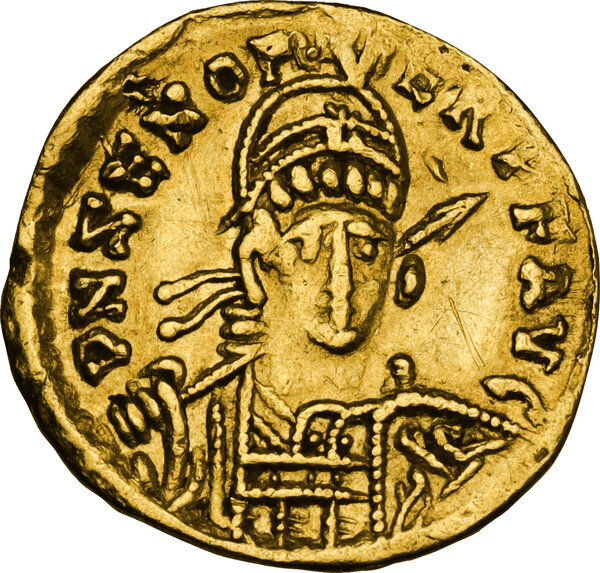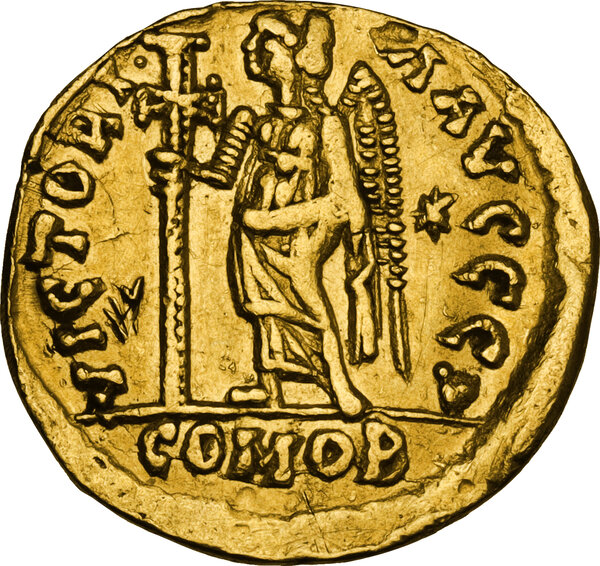Ostrogothic "Zeno" Solidus


拍品号 579:
Ostrogothic Italy, Theoderic as kings of the Goths (474-493). AV Solidus, in the name of Zeno, uncertain mint, c. 490-491 AD. Obv. D N Z (Z inverted)ENO P-ERP F AVG. Pearl-diademed, helmeted and cuirassed bust facing slightly right, holding spear over shoulder and shield. Rev. VICTORI - A AVGGG ? (uncertain letter). Victory standing left, holding long cross; star in right field; in exergue, COMOB. COI pp. 11, fig. 3 (Odovacar); RIC X pp. 215-216 and cf. 3654 (R4); Lacam Class II, 70-71. 4.44 g. 20.50 mm. RRR. Very rare. Slightly bent flan and minor scratch on left reverse field. VF. The western solidi struck in the name of Zeno are of problematic attribution. At the inception of Zeno's second reign, Odovacar controlled Italy, and ostensibly struck coinage there in the name of Zeno. By 488 AD, though, relations between Zeno and Odovacar had deteriorated, and according to the Excerpta Valesiana (11.49), Zeno commanded Theoderic to take Italy from Odovacar. Metlich (COI) argues that the western solidi in Zeno's name were probably issued by Odovacar at Rome, but notes the possibility of some also belonging to Theoderic. Kent (RIC, p. 215) thought that they were struck by both Odovacar and Theoderic, and the differentiation was determined by mint and date of issue, but the distinction was not possible in most cases. For this particular type, however, Lacam notes that the slender portrait, with its high crest, and the outline of the cross on the reverse are the signature characteristics of the northern mints under Theoderic's control. However, Lacam also notes that P-ERP in the obverse legend is a convention of the Rome mint at this time, and the G at the end of the reverse legend appears to be a modification of the traditional G• of Odovacar's issues. Based on these characteristics, Lacam concludes that the issue was struck by Theoderic at a mint in the vicinity of Rome while campaigning against Odovacar. These characteristics could also lead to a conclusion that this is the first issue of Theoderic at Rome following his capture of the city from Odovacar. The legends are a natural progression from those of Odovacar, and the 'northern' mint style could be the result of a transfer of die engravers to Rome from Theoderic's previous mints. The fact that Zeno was dead by the time of Rome's fall to Theoderic (AD 293) led Lacam to conclude that the issue was earlier while Theoderic was on campaign. Nonetheless, it would not be unusual for an issue of this period to be struck in the name of a deceased emperor. Regardless of which theory is correct this is certainly a historically significant issue.
The Ostrogoths were one of a number of Germanic tribes that ravaged the Roman Empire while under the domination of the Huns. After the Hunnic kingdom fell in AD 454, the Ostrogoths were settled in northern Pannonia as foederati. In AD 488, the emperor Zeno called on the Ostrogothic king, Theoderic, to overthrow Odovacar, who had been ruling Italy for the emperor, but had recently become an opponent. Theoderic complied, and hostilities lasted until Odovacar was finally defeated in AD 493. Theoderic was to rule Italy until the emperor arrived, but Zeno died before this occurred. As a result, the Ostrogoths established their own kingdom in Italy, under the authority of the emperor in Constantinople. Over the first thirty years, under Theoderic and then his grandson, Athalaric, Italy experienced a period of relative tranquility. The prosperity of the kingdom was shattered in AD 535, when the Byzantine emperor Justinian I sent his general Belisarius to return Italy to ‘Roman’ rule. Although Belisarius was on the brink of accomplishing this goal, Justinian was forced to recall him to lead the imperial forces against the Persians in the east. Afterward, a quick succession of inept kings followed, until Baduila ascended the throne in AD 541. A popular king, he restored most of Italy to the Ostrogoths and sparked a revival of their fortunes, but was eventually killed in action against the Byzantines at Busta Gallorum in AD 552. His successor, Theia, died that same year, and only a few independent pockets of Ostrogothic resistance held out until the last stronghold was taken in AD 562. (CNG 72, 2006, 2213 note).
The Ostrogoths were one of a number of Germanic tribes that ravaged the Roman Empire while under the domination of the Huns. After the Hunnic kingdom fell in AD 454, the Ostrogoths were settled in northern Pannonia as foederati. In AD 488, the emperor Zeno called on the Ostrogothic king, Theoderic, to overthrow Odovacar, who had been ruling Italy for the emperor, but had recently become an opponent. Theoderic complied, and hostilities lasted until Odovacar was finally defeated in AD 493. Theoderic was to rule Italy until the emperor arrived, but Zeno died before this occurred. As a result, the Ostrogoths established their own kingdom in Italy, under the authority of the emperor in Constantinople. Over the first thirty years, under Theoderic and then his grandson, Athalaric, Italy experienced a period of relative tranquility. The prosperity of the kingdom was shattered in AD 535, when the Byzantine emperor Justinian I sent his general Belisarius to return Italy to ‘Roman’ rule. Although Belisarius was on the brink of accomplishing this goal, Justinian was forced to recall him to lead the imperial forces against the Persians in the east. Afterward, a quick succession of inept kings followed, until Baduila ascended the throne in AD 541. A popular king, he restored most of Italy to the Ostrogoths and sparked a revival of their fortunes, but was eventually killed in action against the Byzantines at Busta Gallorum in AD 552. His successor, Theia, died that same year, and only a few independent pockets of Ostrogothic resistance held out until the last stronghold was taken in AD 562. (CNG 72, 2006, 2213 note).
起拍价 € 1200
当前出价 € 5600
出价数: 14
无可供出售
当前出价 € 5600
出价数: 14
无可供出售





